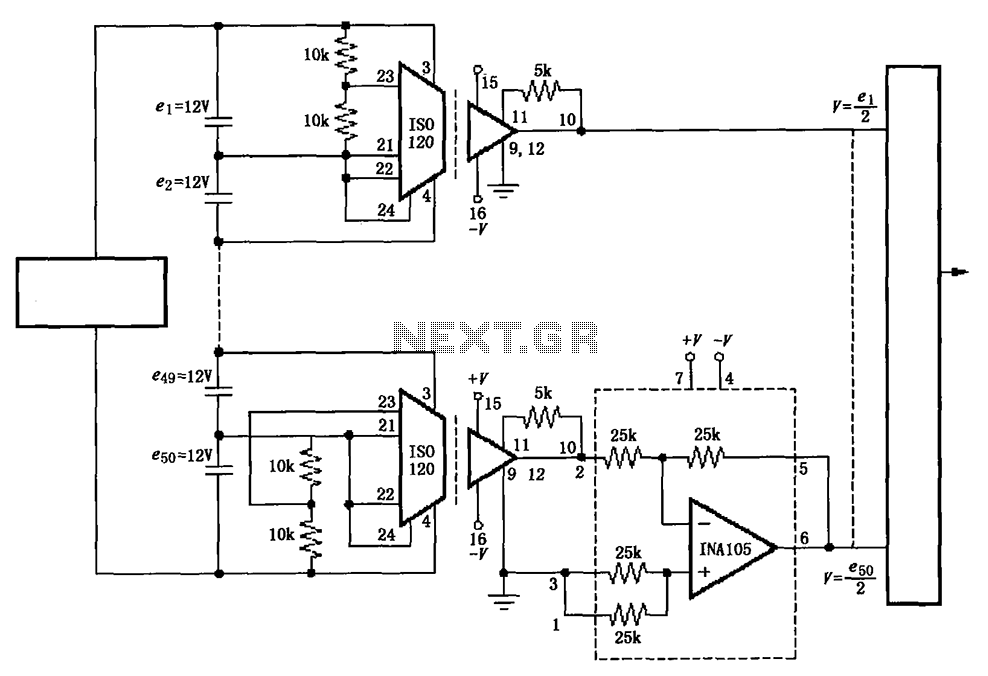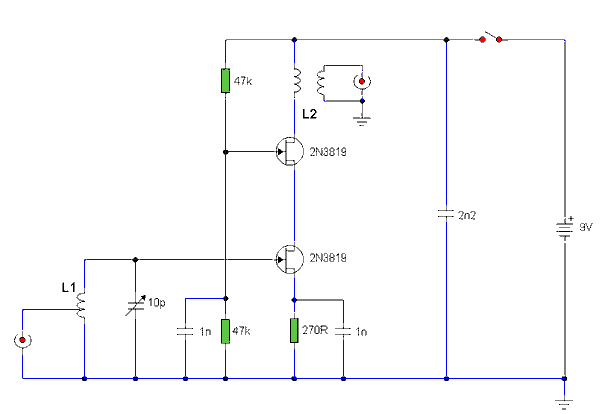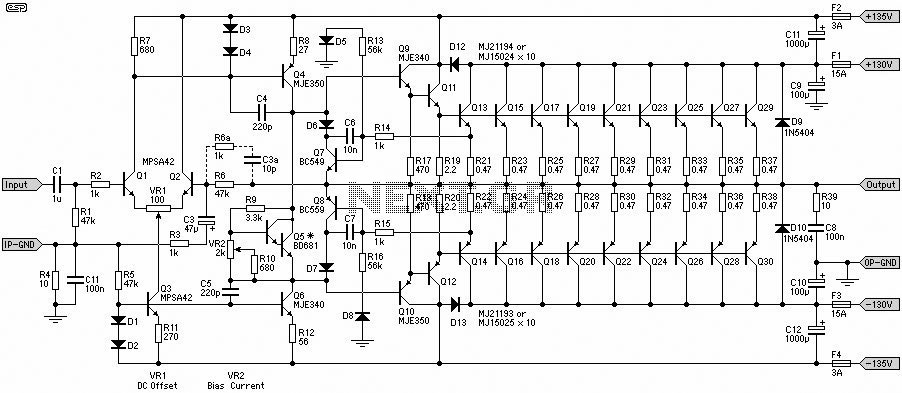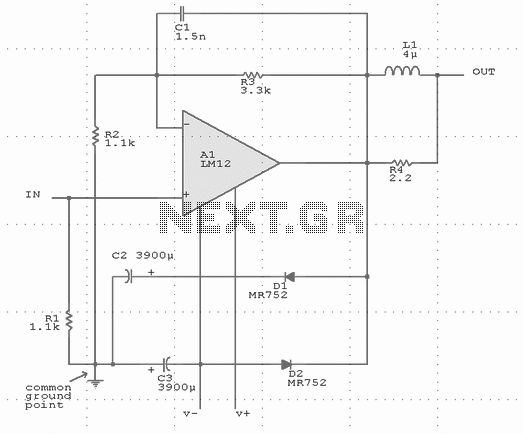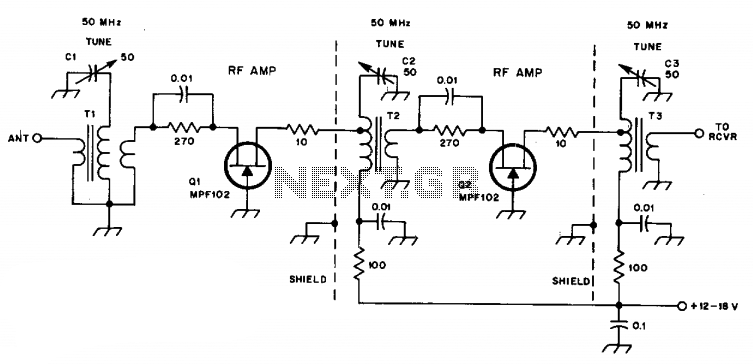
Class A Headphone Amplifier II
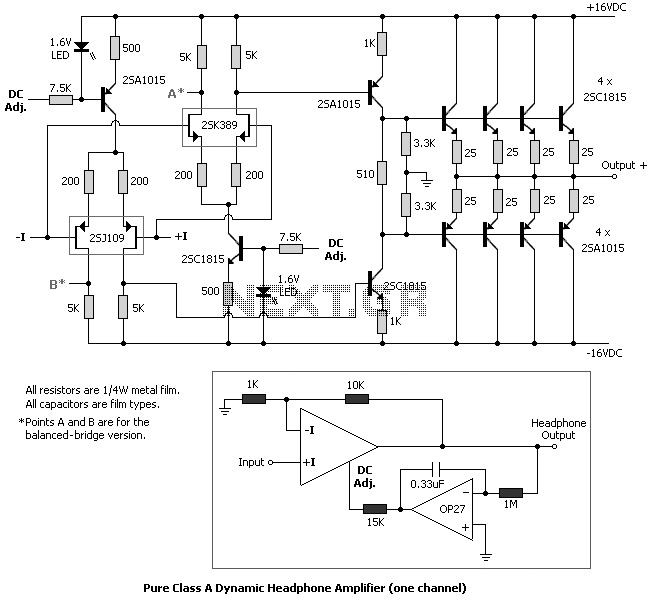
I built this headphone amplifier for dynamic headphones based on my rules of proper audio design. People who know my designs will realize that this amplifier is much more than just a headphone amp. It is a pure class A design containing a new never-before-seen servo loop that is not part of the audio signal chain in any way. Capacitors in the audio signal path are BAD. Even the best silver-mica or poly caps exhibit non-linearities at low voltage levels. Capacitors belong in power supply sections and nowhere else. Capacitors used to compensate an amplifier generally mean that the amplifier is otherwise unstable, with poles in the right half plane and is therefore a bad design. Transformers in the audio signal path are even worse: non-linearities in the gain structure, parasitic capacitance between windings, impedance problems.... Transformers belong in linear power supplies and nowhere else. Ultra high open loop gain: REAL, REAL BAD!!! That basically means anything with an opamp in it. Opamp circuits with open loop gains of 10,000 or more require large amounts of feedback to make them usable. While this reduces THD, the intermodulation products, and especially the transient intermodulation products are much higher than they should be. The schematic for the standard (non-bridged output) version of the headphone amplifier is shown in figure 1. The open loop gain of the amplifier is about 35. Even with the feedback removed, the THD is less than .01%. That's important because the more linear an amplifier is without feedback, the more the THD, IM and TIM distortions are reduced to unmeasurable levels with feedback added. Stage 1 is a dual FET fully-differential fully-balanced front-end. The idling current is 2mA total per dual FET (1mA per FET) and 4mA for the complete front-end stage which consists of both dual FETs. The dual FETs generate the bias which runs the second stage, and keeps it and the resulting output section in class A at all times. The FETs are ultra low noise dual units specifically designed for audio uses. The total voltage gain of the first stage is 50. Stage 2 is the driver stage. It is a standard class A voltage amplifier - in this case used as a voltage shifter. The voltage gain is 0.5 and the idling current 4.3mA. The push-pull class A output stage is a series of paralleled emitter follower, current buffers. The voltage gain is 0.9 and the current gain is 75. The idling current is 15mA per transistor (or 60mA for the 8 transistors off the +16VDC rail and 60mA for the 8 transistors off the -16VDC rail). The output section is designed to operate at an idling current of 15mA each, which is considered optimal for these transistors. The output impedance is maintained at less than 0.1 ohm, necessitating a considerable amount of current. The servo circuit is innovative, diverging from traditional designs that incorporate the output of the DC servo back into the negative leg of the amplifier. This design choice avoids introducing noise and non-linearities from the opamp into the audio loop. The servo integrates the DC output and applies it to the midpoint of two LEDs, which are sensitive to current changes. The servo's design includes a large integration capacitor and a 1 meg resistor, resulting in a filter frequency of 0.05 Hz. The servo opamp's noise is minimized to tens of microvolts, ensuring it does not significantly affect the current sources. For high impedance headphones, a small amount of DC is tolerable, but for low impedance models, even minor DC offsets can cause damage over time. The stability of the amplifier is contingent upon using hand-matched components and high-quality resistors, with the prototype achieving less than 6mV of output DC over extended periods. The principle of not including servo loops in the audio feedback loop is emphasized, as conventional servo designs can introduce non-linearities that degrade audio quality.I built this headphone amplifier for dynamic headphones based on my rules of proper audio design. People who know my designs will realize that this amplifer is much more than just a headphone amp. It is a pure class A design containing a new never-before-seen servo loop that is not part of the audio signal chain in any way. Capacitors in the audio signal path are BAD. Even the best silver-mica or poly caps exhibit non-linearities at low voltage levels. Capacitors belong in power supply sections and nowhere else. Capacitors used to compensate an amplifer generally mean that the amplifier is otherwise unstable, with poles in the right half plane and is therefore a bad design.
Transformers in the audio signal path are even worse: non-linearities in the gain structure, parasitic capacitance between windings, impedance problems.... Transformers belong in linear power supplies and nowhere else. Ultra high open loop gain: REAL, REAL BAD!!! That basically means anything with an opamp in it. Opamp circuits with open loop gains of 10,000 or more require large amounts of feedback to make them usable.
While this reduces THD, the intermodulation products, and especially the transient intermodulation products are much higher than they should be. The schematic for the standard (non-bridged output) version of the headphone amplifier is shown in figure 1.
The open loop gain of the amplifer is about 35. Even with the feedback removed, the THD is less than .01%. That's important because the more linear an amplifier is without feedback, the more the THD, IM and TIM distortions are reduced to unmeasurable levels with feedback added. Stage 1 is a dual FET fully-differential fully-balanced front-end. The idling current is 2mA total per dual FET (1mA per FET) and 4mA for the complete front-end stage which consists of both dual FETs.
The dual FETs generate the bias which runs the second stage, and keeps it and the resulting output section in class A at all times. The FETs are ultra low noise dual units specifically designed for audio uses. The total voltage gain of the first stage is 50. Stage 2 is the driver stage. It is a standard class A voltage amplifier - in this case used as a voltage shifter. The voltage gain is 0.5 and the idling current 4.3mA. The push-pull class A output stage is a series of paralleled emitter follower, current buffers. The voltage gain is 0.9 and the current gain is 75. The idling current is 15mA per transistor (or 60mA for the 8 transistors off the +16VDC rail and 60mA for the 8 transistors off the -16VDC rail).
I have designed the output section to run at what I have determined is the sweet spot for these transistors, which is 15mA each. Yeah, it gets hot; its supposed to get hot (but not hot enough to require heatsinks). It's not possible to make an amplifier with an output impedance less than 0.1 ohm without throwing around a fair amount of current.
The servo circuit is new: most of the servo designs (Mark Levinson and Krell, for example) put the output of the DC servo back into the - leg of the amplifier. I just do not like this. That puts the noise and non-linearities of the opamp inside the audio loop. My servo feeds back to the current sources for the dual FETs in stage 1. Like all servos, it is an integrator. Due to the large (relatively) integration capacitor and the 1 meg resistor, the frequency of this filter is 0.05 Hz.
With even a decent opamp, the servo's noise is in the tens of microvolts, and does not affect the operation of the current sources significantly. The servo opamp in this amplifier measures the DC at the output, if any, integrates it and applies it to the midpoint of the two LEDs.
The LEDs do have a slight change in voltage with respect to current, about 3 or 4%, and that is enough to make the servo work. Notice that if the transistors or the resistors are very poorly matched, the servo will not work because its total control range is at most 10%.
Most standard servos (such as the Mark Levinson or Krell servos) have a much wider range. For high impedance headphones, a little DC will not hurt the phones. With the low impedance Grados, even 0.1VDC over a long period of time will definitely damage and/or change the sound. If all the parts are hand matched, the power supplies are exactly the same and all the resistors are really good quality, the amp should be stable and should not drift.
In that case, the servo could be omitted or replaced with a 20K trimmer pot wired from +16VDC to -16VDC, with the wiper going to the DC adjust pin. The prototype uses 0.05% tolerance resistors, and I hand-matched the transistors. The output DC is less than 6mV and has stayed absolutely stable for the few months I have had the unit.
Servo loops MUST NOT be in the audio feedback loop. This rule is also very important. Two of my favorite high-end audio electronics manufacturers put servo loops into the minus input of their amplifiers. Most other manufacturers that use servo loops do the same thing. opamps used for servo loops do not have an output impedance low enough to make them suitable for this purpose.
Furthermore the dynamic output impedance of opamps adds non-linearities to the audio when put in series with the gain resistor on the minus input. 🔗 External reference
Transformers in the audio signal path are even worse: non-linearities in the gain structure, parasitic capacitance between windings, impedance problems.... Transformers belong in linear power supplies and nowhere else. Ultra high open loop gain: REAL, REAL BAD!!! That basically means anything with an opamp in it. Opamp circuits with open loop gains of 10,000 or more require large amounts of feedback to make them usable.
While this reduces THD, the intermodulation products, and especially the transient intermodulation products are much higher than they should be. The schematic for the standard (non-bridged output) version of the headphone amplifier is shown in figure 1.
The open loop gain of the amplifer is about 35. Even with the feedback removed, the THD is less than .01%. That's important because the more linear an amplifier is without feedback, the more the THD, IM and TIM distortions are reduced to unmeasurable levels with feedback added. Stage 1 is a dual FET fully-differential fully-balanced front-end. The idling current is 2mA total per dual FET (1mA per FET) and 4mA for the complete front-end stage which consists of both dual FETs.
The dual FETs generate the bias which runs the second stage, and keeps it and the resulting output section in class A at all times. The FETs are ultra low noise dual units specifically designed for audio uses. The total voltage gain of the first stage is 50. Stage 2 is the driver stage. It is a standard class A voltage amplifier - in this case used as a voltage shifter. The voltage gain is 0.5 and the idling current 4.3mA. The push-pull class A output stage is a series of paralleled emitter follower, current buffers. The voltage gain is 0.9 and the current gain is 75. The idling current is 15mA per transistor (or 60mA for the 8 transistors off the +16VDC rail and 60mA for the 8 transistors off the -16VDC rail).
I have designed the output section to run at what I have determined is the sweet spot for these transistors, which is 15mA each. Yeah, it gets hot; its supposed to get hot (but not hot enough to require heatsinks). It's not possible to make an amplifier with an output impedance less than 0.1 ohm without throwing around a fair amount of current.
The servo circuit is new: most of the servo designs (Mark Levinson and Krell, for example) put the output of the DC servo back into the - leg of the amplifier. I just do not like this. That puts the noise and non-linearities of the opamp inside the audio loop. My servo feeds back to the current sources for the dual FETs in stage 1. Like all servos, it is an integrator. Due to the large (relatively) integration capacitor and the 1 meg resistor, the frequency of this filter is 0.05 Hz.
With even a decent opamp, the servo's noise is in the tens of microvolts, and does not affect the operation of the current sources significantly. The servo opamp in this amplifier measures the DC at the output, if any, integrates it and applies it to the midpoint of the two LEDs.
The LEDs do have a slight change in voltage with respect to current, about 3 or 4%, and that is enough to make the servo work. Notice that if the transistors or the resistors are very poorly matched, the servo will not work because its total control range is at most 10%.
Most standard servos (such as the Mark Levinson or Krell servos) have a much wider range. For high impedance headphones, a little DC will not hurt the phones. With the low impedance Grados, even 0.1VDC over a long period of time will definitely damage and/or change the sound. If all the parts are hand matched, the power supplies are exactly the same and all the resistors are really good quality, the amp should be stable and should not drift.
In that case, the servo could be omitted or replaced with a 20K trimmer pot wired from +16VDC to -16VDC, with the wiper going to the DC adjust pin. The prototype uses 0.05% tolerance resistors, and I hand-matched the transistors. The output DC is less than 6mV and has stayed absolutely stable for the few months I have had the unit.
Servo loops MUST NOT be in the audio feedback loop. This rule is also very important. Two of my favorite high-end audio electronics manufacturers put servo loops into the minus input of their amplifiers. Most other manufacturers that use servo loops do the same thing. opamps used for servo loops do not have an output impedance low enough to make them suitable for this purpose.
Furthermore the dynamic output impedance of opamps adds non-linearities to the audio when put in series with the gain resistor on the minus input. 🔗 External reference
